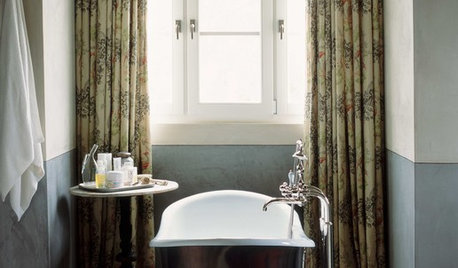Drywall over Plaster plus new electrical
MrLiquid
11 years ago
Related Stories

MATERIALSRaw Materials Revealed: Drywall Basics
Learn about the different sizes and types of this construction material for walls, plus which kinds work best for which rooms
Full Story
HOUSEKEEPINGQuick Fix: How to Patch a Drywall Hole
Dents and dings disappear, leaving your walls looking brand new, with this fix that even a novice can do
Full Story
WALL TREATMENTSSurface Smarts: Venetian Plaster
Centuries-old Venetian plaster has made a roaring comeback in modern interiors. Could this old-world wall favorite work in your home?
Full Story
DECORATING GUIDESDecorating Secrets: Picture-Perfect Way to Hang Art
Save your drywall with these easy steps for hanging framed pieces
Full Story
ACCESSORIESHow to Hide Those Messy Wires
Untangle Yourself From Ugly Electrical Cords With a Few Tricks and Accessories
Full Story
REMODELING GUIDESBathroom Workbook: How Much Does a Bathroom Remodel Cost?
Learn what features to expect for $3,000 to $100,000-plus, to help you plan your bathroom remodel
Full Story
MOST POPULAR8 Beautiful Ideas for Floating Shelves
Get clean-lined storage and display on walls, over windows and in nooks using versatile floating shelving
Full Story
FUN HOUZZ10 Things People Really Don’t Want in Their Homes
No love lost over fluorescent lights? No shocker there. But some of these other hated items may surprise you
Full Story
MOST POPULARThe Right Way to Test Paint Colors
Here are 5 key steps to take to ensure you're happy with your wall paint color
Full Story
LIGHTINGGet Your Home's Recessed Lighting Right
Learn the formula for how much light a room needs plus how to space downlights, use dimmers and more
Full Story








southerncanuck
geller
Related Professionals
East Islip Kitchen & Bathroom Designers · Hershey Kitchen & Bathroom Designers · Portland Kitchen & Bathroom Designers · Reedley Kitchen & Bathroom Designers · Feasterville Trevose Kitchen & Bathroom Remodelers · Beverly Hills Kitchen & Bathroom Remodelers · Fremont Kitchen & Bathroom Remodelers · Garden Grove Kitchen & Bathroom Remodelers · Oxon Hill Kitchen & Bathroom Remodelers · Rochester Kitchen & Bathroom Remodelers · Shawnee Kitchen & Bathroom Remodelers · Toledo Kitchen & Bathroom Remodelers · Keansburg Architects & Building Designers · Portsmouth Architects & Building Designers · Nanticoke Architects & Building DesignersMrLiquidOriginal Author
brickeyee
MrLiquidOriginal Author
jmc01
MrLiquidOriginal Author
katy-lou
columbusguy1
texasredhead
brickeyee
civ_IV_fan
brickeyee
civ_IV_fan
Debbie Downer
brickeyee
sombreuil_mongrel
User
brickeyee
civ_IV_fan
brickeyee
sombreuil_mongrel
brickeyee